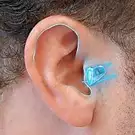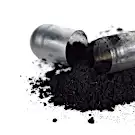5 Reasons Why Your Belly Button Hurts Like Hell
Seriously, what's going on?

GETTY IMAGES
Most of the time, we give little to no thought to our belly buttons. Some of us get them pierced. And, hopefully, every once in a while, all of us scrub out any lint that's hanging around in there. But that's about it.
That is, until we feel a weird case of belly button pain. ("Oh, hi, it's you.") And while belly button pain can come and go, and be no big deal, sometimes, it's a sign that somethings really (really) wrong.
So if you've got a pang in your belly button, what should you do? “People should really be making their first stop their primary care doctor to decide what’s important and what’s not, what’s worrisome and what’s not,” says Elana Maser, M.D., assistant professor of gastroenterology at the Icahn School of Medicine at Mount Sinai. (She also recommends keeping an eye out for red-flag symptoms: if you have a fever, there's blood in your stool, you can’t keep food down; or you're not urinating, immediately have someone take you to an emergency room.)
And because the causes can be so different, treatments vary widely, too. Depending on your underlying condition, your doctor might refer you to a gastroenterologist, general surgeon, or even a dermatologist. Meanwhile, more benign causes might not warrant anything more than an antacid or a change in diet.
Wondering what's behind your belly button pain? Here, experts share five potential causes—and how to deal with each.
1
CROHN’S DISEASE
An inflammatory bowel disease that usually affects the small intestine and/or colon, Crohn’s disease can cause pain behind the belly button that feels like anything from a dull ache to a sharp, cramping pain that typically occurs 20 to 30 minutes after eating. “But when you make a Crohn’s diagnosis, it’s never made based solely on presence of abdominal pain. You need other symptoms,” says Maser. Those can include severe diarrhea, fatigue, and weight loss.
According to the Mayo Clinic, the cause of Crohn’s disease is unknown, but a malfunctioning immune system and a family history likely play a role. Over 1 million people in the U.S. have Crohn’s disease, according to Maser. “The most common age is between 18 to 24, but you can get it at any age,” she says.
Complications from Crohn’s disease can include malnutrition, ulcers, and bowel obstruction. If your doctor suspects you might have the condition, he or she will run tests, usually a colonoscopy or abdominal imaging like a CT scan or an MRI. Treatment may involve anti-inflammatory drugs, immune-system suppressors, antibiotics, or vitamin supplements. Your doctor may also put you on bowel rest (feeding you through a tube or intravenously) or otherwise suggest changes to your diet. If none of these work, you may need surgery.
2
UMBILICAL STRANGULATION
When you’re born, doctors cut your umbilical cord—the tube that fed you during pregnancy—and the surrounding muscles heal. Sometimes, however, those abdominal muscles don’t quite close all the way. When intestines or fatty tissue push through this opening, it creates a large bulge at the belly button known as an umbilical hernia. Umbilical hernias happen in about one in five newborns, according to Johns Hopkins Medicine, with 90 percent healing by the time a person is 5 years old.
For the other 10 percent of people—three times more females than males, says Maser—the hernia remains. “Usually with an umbilical hernia your umbilicus is bigger than usual. There’s tissue or a membrane you can feel coming out that’s soft and doesn’t feel like the surrounding skin, and you can push it back in,” says Maser.
It’s possible to live with an umbilical hernia your whole life without any problems. However sometimes protruding tissue can become trapped and deprived of blood supply, a condition known as a strangulated umbilical hernia. “Once it becomes painful, it can mean it’s squeezing on your omentum [tissue in the stomach] or bowel,” says Maser. If blood supply is cut off, tissue can die and potentially lead to life-threatening infection. If your doctor thinks you have a strangulated hernia, he or she may order a CT scan, X-ray, or MRI. If necessary, they'll surgically remove the affected tissue right away.
So if you have an umbilical hernia, it’s a good idea to know the symptoms of a strangulated hernia: Besides pain at your belly button, you may notice that you can’t push tissue back inside your belly button, and you may have a red or purple bulge at the belly button, constipation, fever, swelling of the abdomen, and vomiting.
Constipated? Try these remedies:
Constipation Remedies
0:01
/
0:52
Loaded: 0%
MORE CONTENT
 HNO-Ärzte verblüfft von diesen Siemens-HörgerätenHear.com
HNO-Ärzte verblüfft von diesen Siemens-HörgerätenHear.com How to Invest in Marijuana Part IIEquedia
How to Invest in Marijuana Part IIEquedia (Top 5) The Best Antivirus Products For YouMy Antivirus Review
(Top 5) The Best Antivirus Products For YouMy Antivirus Review 7 Sneaky Signs Your Blood Sugar Is Too HighWomen's Health
7 Sneaky Signs Your Blood Sugar Is Too HighWomen's Health Can Activated Charcoal Pills Detox Your BodyWomen's Health
Can Activated Charcoal Pills Detox Your BodyWomen's Health This Is Why Your Vagina Is So Itchy—And How To Make It StopWomen's Health
This Is Why Your Vagina Is So Itchy—And How To Make It StopWomen's Health
FEAR OF MISSING OUT?
DON'T MISS OUT ANYMORE!
You may unsubscribe at any time.
3
INDIGESTION
While gas, for example, is typically felt more in the upper abdomen all the way up to the shoulders, indigestion is most often felt above the belly button, explains Maser. However, the food you eat can also cause discomfort and pain anywhere in your abdomen, as well as a full or nauseous feeling that lasts a few hours.
Fatty foods, fried foods, and spicy foods are the most common indigestion triggers. “Anything with fat in it takes longer to digest, so it sits in the stomach for longer periods. Even if you’re having fish, if it’s fried in too much oil that counts,” says Maser.
To combat indigestion, the National Institutes of Health suggests skipping these foods, eating slowly, chewing food completely, and avoiding exercise right after a meal. Antacids can help relieve temporary discomfort, but let your doctor know if your symptoms last longer than a few days.
RELATED: THIS MODEL LOST A LEG TO TOXIC SHOCK SYNDROME—AND NOW SHE MIGHT LOSE THE OTHER
4
APPENDICITIS
The appendix is a teeny organ located where the big and small intestines meet. According to Johns Hopkins Medicine, about one out of every 1,000 Americans is affected by appendicitis, or inflammation of the appendix, and the first symptom is often pain around the belly button. “Typically appendicitis starts as more of a severe pain in the middle of the stomach. Within hours it makes its way to the right lower quadrant of the abdomen,” says Maser.
Doctors don’t know what causes appendicitis, but it’s most common in people between the ages of 15 and 30 and tends to run in families, according to the Cleveland Clinic. And it requires immediate medical attention. If your appendix ruptures—which can occur within 48 to 72 hours after symptoms start—the resulting infection can be life-threatening.
So keep an eye out for pain that tends to get worse as time goes on and usually increases when you breathe deeply or move, as well as other symptoms including nausea, vomiting, fever (usually under 100 degrees Fahrenheit), diarrhea, constipation, and lack of appetite. If your doctor suspects appendicitis, he or she may run tests including an ultrasound. You’ll be observed for 12 to 24 hours and, if the condition is severe, you may have your appendix removed.
RELATED: 5 SIGNS YOUR APPENDIX IS ABOUT TO BURST
5
GALLSTONES
Gallstones occur when small, hard deposits that are usually made of cholesterol build up in the gallbladder—the organ that holds digestive juice known as bile. You may develop just one gallstone, or you may develop many, and they can range in size from a poppy seed to a golf ball. About 10 to 15 percent of Americans get gallstones, and 90 percent don’t know they have them since they rarely lead to complications, according to the University of Maryland Medical Center. “Gallstones are most typical in women who are in their forties and who are overweight,” says Maser.
Sometimes, however, gallstones lodge in a duct and cause a blockage, resulting in abdominal pain. The most common symptom is sudden, intensifying pain in the center of your abdomen, just below your breastbone, according to the Mayo Clinic. However “it’s hard to localize pain,” says Maser, which is why you might experience what feels like belly button pain when you’re passing a gallstone. Cramping and, in some cases, constant pain lasts for eight or nine hours, until the gallstone passes.
If the pain doesn’t go away within a few hours or if it’s debilitating, or if you have yellowish skin or a high fever with chills, check in with a doctor to rule out a complication like gallbladder inflammation. In some cases your doctor may prescribe medications to dissolve the gallstones or surgery to remove your gallbladder, according to the Mayo Clinic.
No comments:
Post a Comment